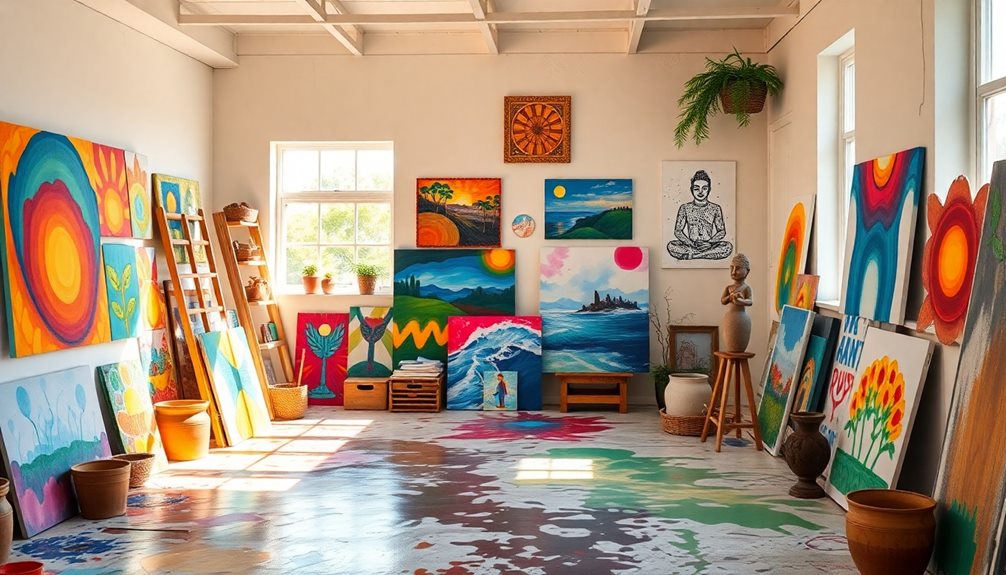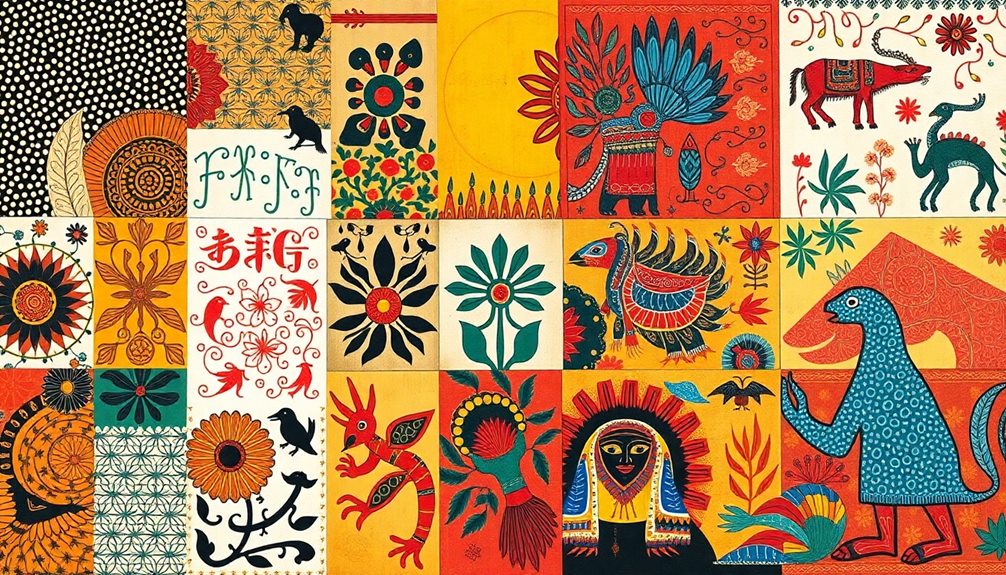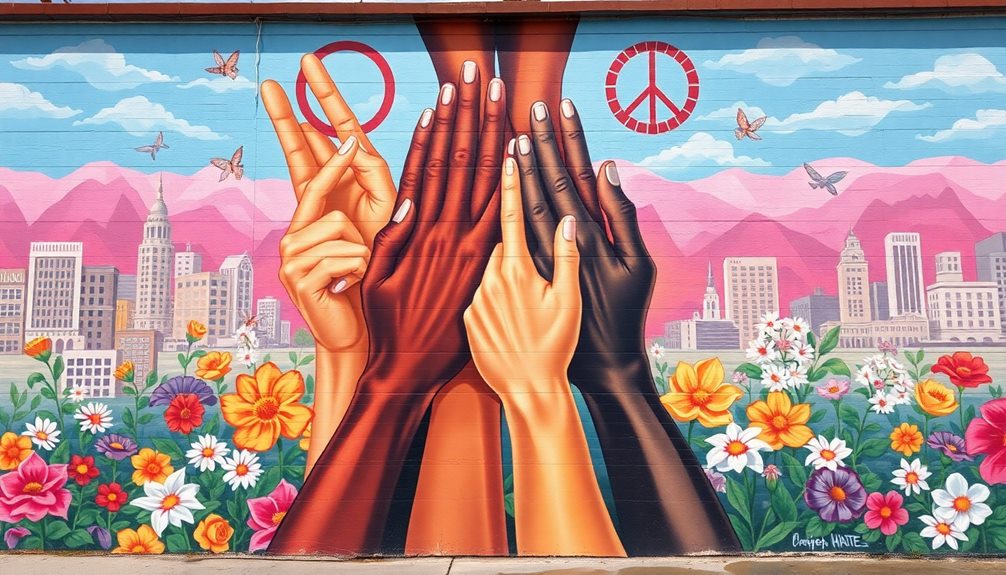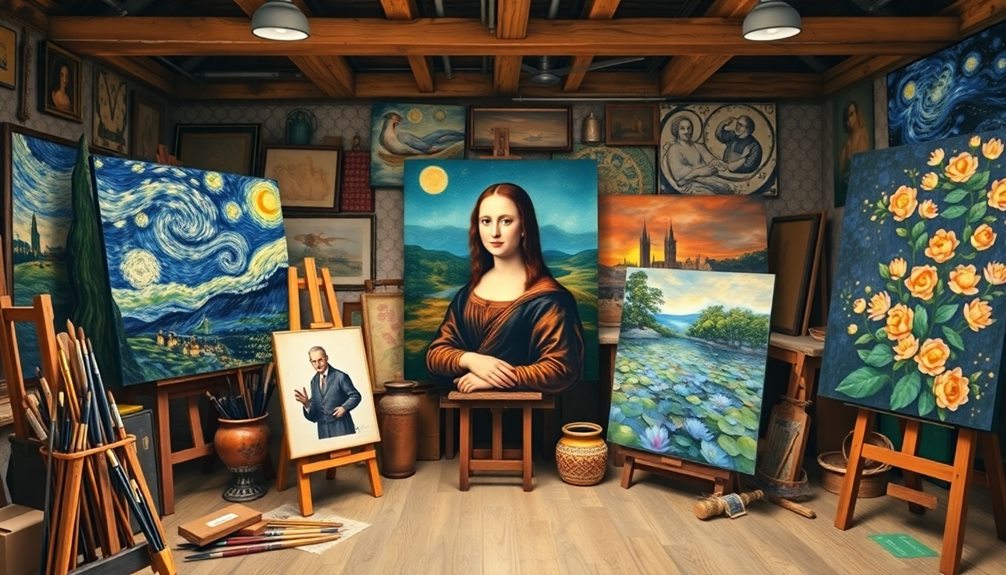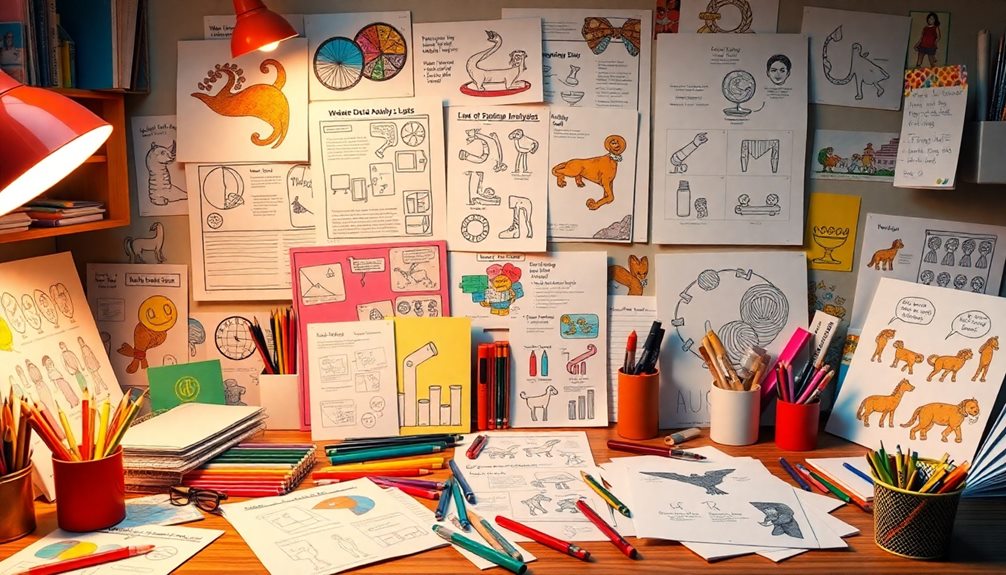Engaging with art greatly boosts your mental health and emotional well-being. It allows you to express complex feelings non-verbally, providing a safe outlet for emotions. Whether it's painting, drawing, or participating in community art projects, these activities can reduce stress and anxiety while enhancing self-awareness. You'll find that art fosters a sense of accomplishment, promoting personal growth. Plus, art therapy effectively addresses mental health issues like depression and PTSD. By tapping into your creativity, you can access deeper connections with yourself and others, leading to emotional healing. Discover how art can transform your mental landscape further.
Key Takeaways
- Engaging with art enhances mindfulness, promoting present-moment awareness and reducing anxiety through focused creative activities.
- Art serves as a powerful non-verbal outlet for emotional expression, fostering deeper self-understanding and improving emotional intelligence.
- Creative activities provide significant stress relief, distracting from daily stressors and lowering cortisol levels through enjoyable artistic expression.
- Community art initiatives build social connections, reduce loneliness, and boost overall emotional stability through collective creative engagement.
- Creative arts therapy effectively addresses mental health issues, promoting healing through artistic expression tailored to individual emotional needs.
The Role of Art in Mindfulness
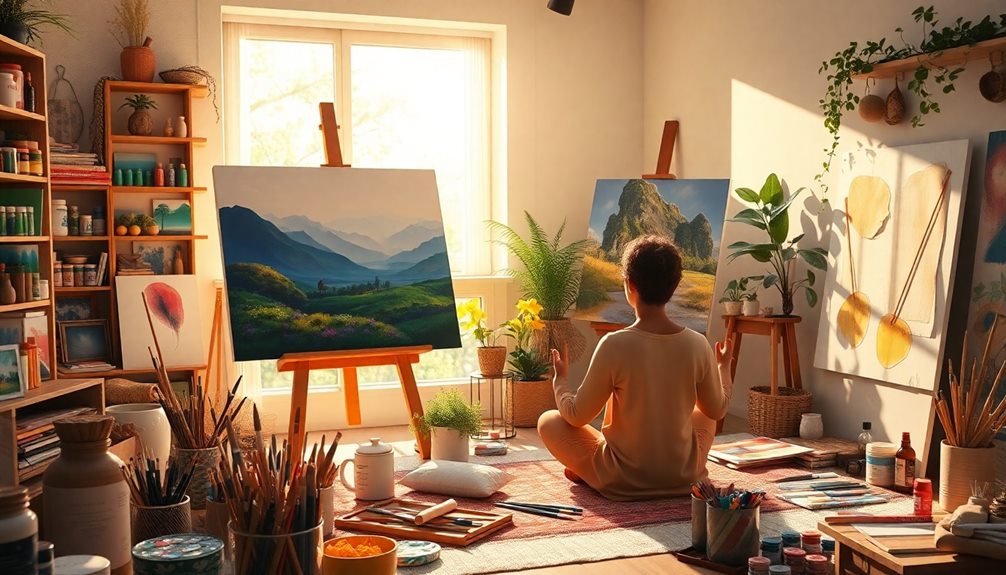
Have you ever noticed how engaging with art can pull you into the present moment? When you immerse yourself in creative activities like watercolor painting, you experience a state of flow where time seems to stand still. This process requires your full concentration, effectively quieting your mind and enhancing self-awareness—key components of mindfulness.
By focusing on the textures, colors, and forms, you cultivate a deep awareness that allows you to fully embrace the creative experience. Additionally, incorporating such practices can serve as a form of stress management, helping to alleviate anxiety and promote a sense of calm.
Regularly engaging in these artistic activities can greatly improve mental health. The repetitive motions involved in art can soothe your mind and lower cortisol levels, helping you find inner peace and reduce stress.
Studies show that even minimal, consistent creative practices can yield substantial mental health benefits, reinforcing the idea that art therapy is a powerful tool for enhancing mindfulness.
Emotional Expression Through Art

Art provides you with a unique outlet to express your emotions in ways words often can't capture.
By engaging in creative activities, you can communicate feelings like joy or sadness non-verbally, which can lead to deeper self-understanding.
This process not only helps you explore your emotions but also fosters a sense of accomplishment and boosts your overall well-being.
Artistic Outlets for Emotions
In the domain of emotional expression, artistic outlets serve as powerful tools for maneuvering complex feelings. When you engage in creative activities, you create a safe space to explore emotions like joy, sadness, and anger. This freedom allows you to express what's often difficult to articulate. Through art, you can gain insights into your feelings, enhancing your emotional intelligence.
Studies show that art therapy has proven effective for mental health conditions such as depression and PTSD. By facilitating emotional processing, it helps you understand and manage your experiences better. Additionally, the act of creating can greatly reduce stress and anxiety levels, promoting an overall sense of well-being.
Transferring emotions into art not only helps you process difficult feelings but also boosts your mood and self-esteem. You'll often find that seeing your emotions manifest in your work brings a sense of accomplishment, contributing to personal growth.
Non-Verbal Communication Benefits
Throughout history, creative expression has served as an essential means of non-verbal communication, allowing individuals to convey emotions that words often fail to capture. Engaging in art provides you with a powerful outlet for expressing complex feelings, whether it's joy, sadness, or anger. Without the constraints of language, you can explore and process these emotions more freely.
Studies show that art-making enhances emotional intelligence by fostering self-awareness and helping you identify and express your feelings. When you participate in creative activities like painting or drawing, you tap into therapeutic channels that can alleviate anxiety and depression, ultimately improving your emotional well-being.
Art therapy, in particular, proves beneficial for those facing communication challenges, such as individuals with trauma or mental health disorders. By creating art, you can share your experiences and emotions in a way that feels safe and accessible.
This form of non-verbal communication not only helps you articulate what might be difficult to say but also strengthens your emotional connections with others. Embracing art as a means of expression can be a transformative journey toward healing and understanding.
Art as a Stress Reliever
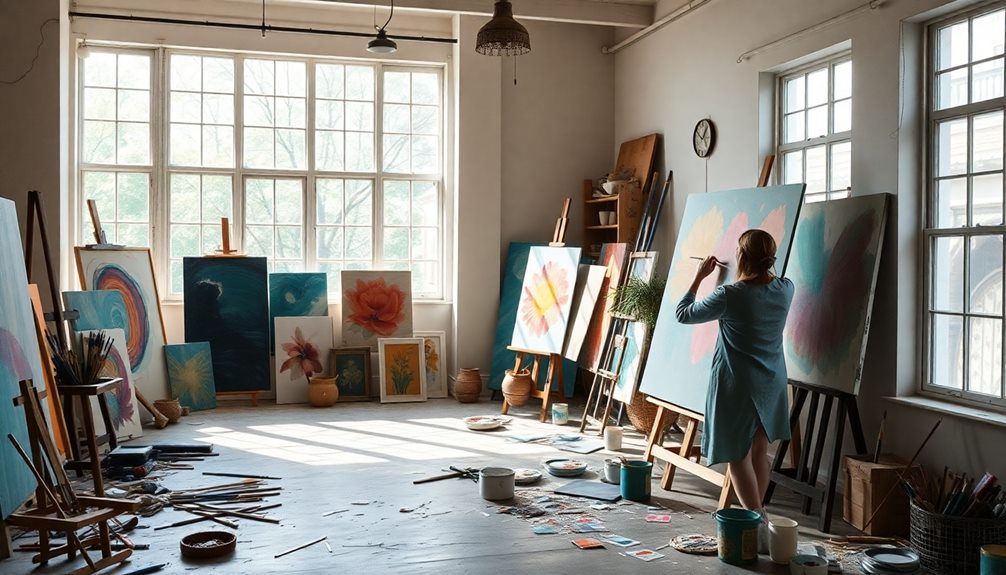
When you pick up a brush or pencil, the act of creating can instantly transport you away from daily stressors. Engaging in artistic activities like drawing or painting has been shown to lower cortisol levels, effectively reducing stress and anxiety.
Even a brief creative session, lasting just a few minutes, can provide significant mental health benefits, offering a valuable respite from the pressures of life.
The repetitive motions involved in art-making, such as the rhythmic strokes of painting, soothe your mind and promote relaxation, contributing to your overall well-being.
Studies indicate that individuals who regularly participate in creative activities report lower levels of stress and improved mood, emphasizing the therapeutic power of art.
What's essential is that the enjoyment derived from engaging in art, regardless of your skill level, plays a significant role in stress relief.
You don't need to be a professional artist to reap these benefits; the simple act of creative expression is accessible to everyone.
Benefits of Community Art Engagement
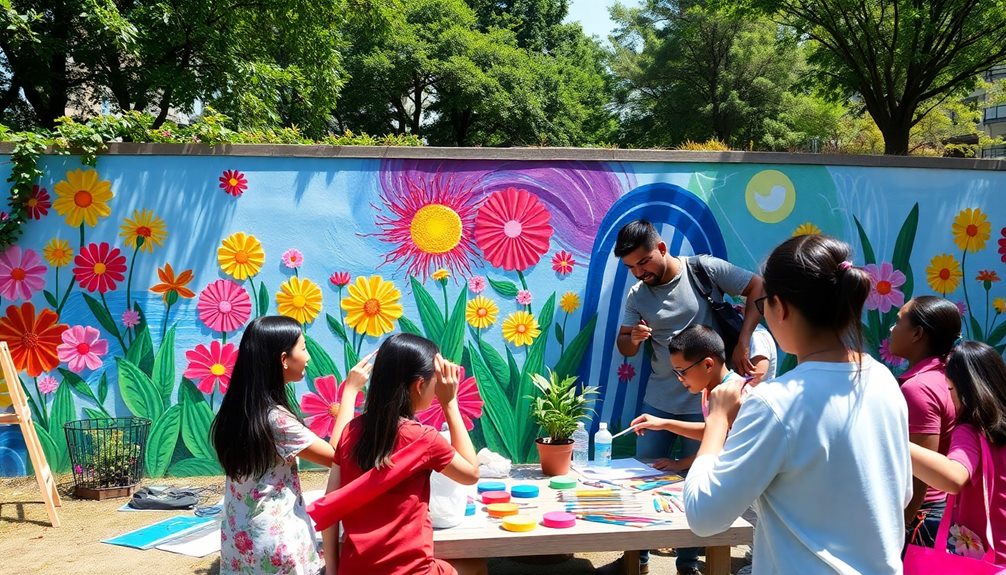
Community art engagement offers a profound sense of connection and belonging that can greatly enhance mental health. When you participate in community art programs, you're not just creating art; you're forming relationships and building support networks. This is especially vital for individuals facing mental health conditions, as it helps reduce feelings of loneliness and isolation.
| Benefits | Description | Impact on Mental Health |
|---|---|---|
| Improved Mood | Engaging in creative activities boosts overall well-being. | Enhances emotional stability and positivity. |
| Social Connections | Collaborative art fosters interactions among participants. | Reduces loneliness and builds friendships. |
| Emotional Expression | Art allows for expressing feelings that are hard to verbalize. | Lowers anxiety and stress levels. |
| Empowerment | Taking part in art projects gives a sense of ownership. | Increases resilience and self-esteem. |
Creative Arts Therapy Explained
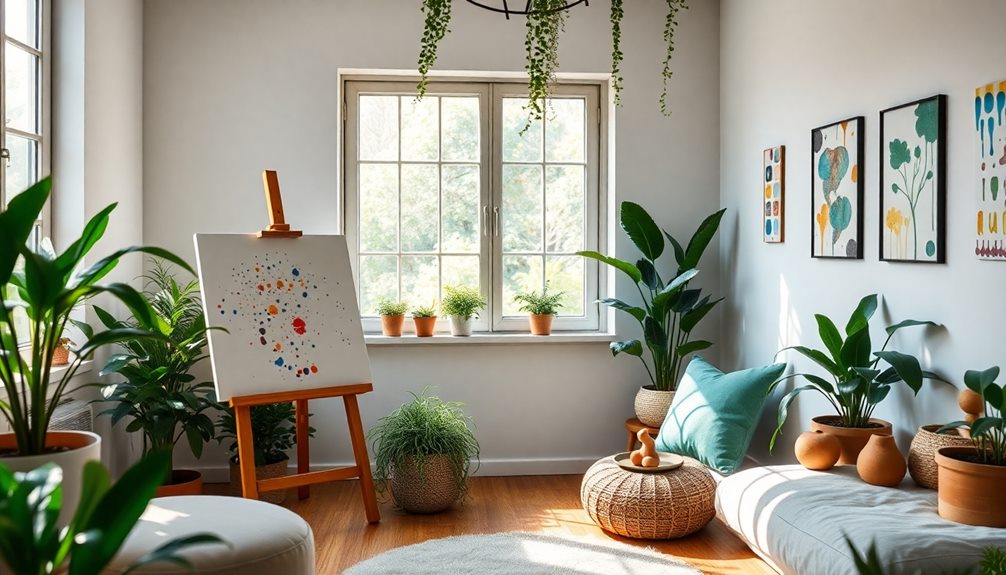
Creative arts therapy harnesses the power of artistic expression to promote healing and emotional well-being. This innovative approach includes activities like music, dance, writing, storytelling, collage-making, and painting, all tailored to meet specific clinical goals and your personal interests.
Originating in the 1940s, creative arts therapy has proven effective for various mental health problems, including anxiety, depression, mood disorders, schizophrenia, and dementia.
What's truly remarkable about this therapy is that success isn't measured by the quality of the art you produce but by your healing process and emotional expression. Research shows that engaging in creative arts therapy can greatly reduce anxiety and blood pressure, increase serotonin levels, and help you gain new perspectives on recovery.
Furthermore, creative arts therapy enhances your engagement during therapy sessions, improving your focus, emotional processing, communication skills, and self-esteem.
Healing Through Artistic Expression
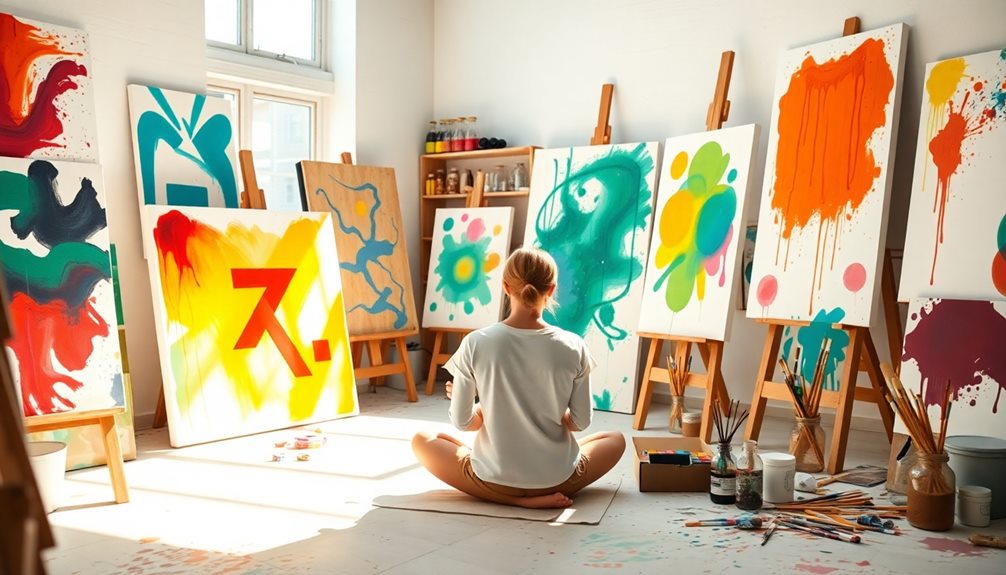
Artistic expression serves as a powerful outlet for healing, allowing you to navigate complex emotions and experiences that may feel overwhelming. Engaging in creative activities like painting, music, or storytelling can considerably improve your mental health.
Research shows that art can help reduce symptoms of anxiety and depression, particularly during vulnerable times like pregnancy and postpartum. In fact, the transformative power of curiosity can also enhance your creative endeavors, enabling you to explore new perspectives and ideas through art.
The creative process fosters emotional release, letting you explore feelings in a safe space. This can lead to enhanced self-esteem and better emotional processing, especially for those dealing with trauma or PTSD.
It's fascinating how consistent engagement in artistic activities, even for just a few minutes each day, can yield benefits akin to regular physical exercise.
Moreover, studies indicate that creating art not only alleviates anxiety but also helps manage pain perception, promoting better recovery in healthcare settings. By expressing yourself creatively, you allow for emotional healing and a deeper connection with your inner self.
Building Artistic Identity
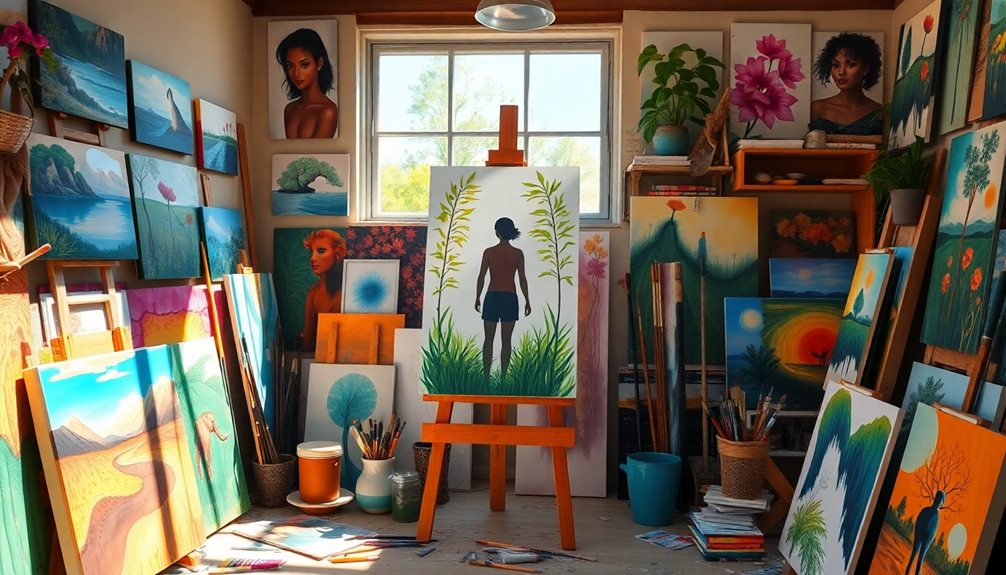
Building your artistic identity is a journey of self-discovery that invites you to experiment with various mediums and techniques. As you engage in different forms of art, you'll begin to define your unique voice in creative expression. This process not only helps in building artistic identity but also improves your mental well-being by enhancing self-awareness.
Reflecting on your personal experiences can inform your artistic choices, fostering deeper emotional understanding. Additionally, just like in the process of manifesting travel experiences, allowing yourself to feel good about your artistic aspirations can elevate your creative journey.
Don't be afraid to explore your creative side. Try painting, sculpting, or digital design—whatever resonates with you. Each experiment offers insight into your preferences and strengths, encouraging continuous growth and evolution as an artist.
Remember, your artistic identity isn't fixed; it can transform over time through practice and exploration.
Finding personal enjoyment in art is essential. When you integrate creative activities into your routine, it strengthens your artistic identity and makes the entire process more fulfilling.
Online courses and community forums can support you along the way, providing valuable resources to help you develop your skills from beginner to advanced levels. Embrace this journey; it's not just about creating art but about discovering who you are.
Resources for Artistic Exploration

A wealth of resources is available to help you investigate and expand your artistic skills. Numerous online platforms offer courses that cater to all levels, enabling you to immerse yourself in various artistic mediums and techniques at your own pace.
YouTube is a treasure trove of free tutorials and demonstrations, making the creative arts accessible to anyone keen to hone their skills or learn new methods.
Blogs dedicated to specific art forms, like watercolor painting, provide invaluable tips, techniques, and inspiration for enhancing your craft. These resources can guide you in your artistic exploration and empower you to express your emotions effectively.
Community forums allow you to connect with fellow artists, share experiences, seek feedback, and foster a supportive environment for growth.
Don't hesitate to experiment with different mediums, such as drawing, painting, or collage-making. This experimentation can lead to self-discovery and help you define your unique artistic voice, promoting your mental health.
Future of Art in Mental Health
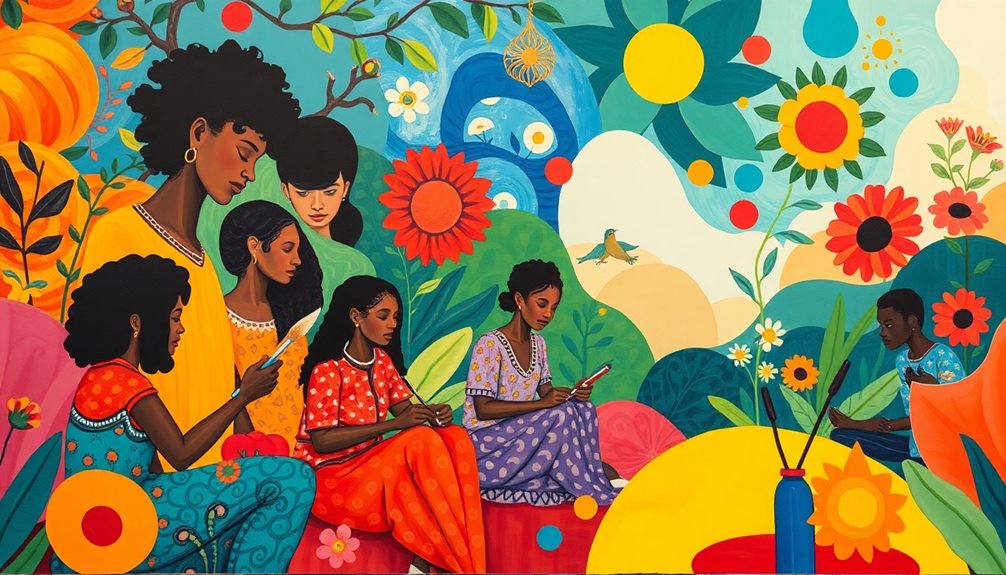
As we look ahead, you'll notice a significant shift towards digital art therapy, making creative expression more accessible than ever.
Community art initiatives are set to flourish, bringing people together and raising awareness about mental health.
Digital Art Therapy Expansion
The rapid expansion of digital art therapy is transforming how individuals access and engage with mental health resources. Thanks to the COVID-19 pandemic, digital art therapy platforms have become more widespread, allowing you to participate from anywhere, even in remote or underserved areas.
These programs often include interactive elements, giving you the chance to connect with experienced therapists through online sessions, which enhances your overall therapeutic experience.
Research shows that online art therapy can effectively reduce symptoms of anxiety and depression, creating a judgment-free space for your self-expression. You'll find that digital tools and art materials are often provided, ensuring you have everything you need to fully engage in the creative arts during virtual sessions.
This accessibility means you can explore your feelings and thoughts through art, regardless of your location.
Looking ahead, the future of digital art therapy is leaning towards hybrid models that combine in-person and digital experiences. This approach expands the reach and effectiveness of therapeutic art interventions, making it easier for you to find the support you need while embracing the healing power of creativity.
Community Art Initiatives
Community art initiatives are revolutionizing the way people engage with mental health support by promoting inclusivity and accessibility. These programs create supportive environments where discussions about mental health become more approachable. By partnering with local artists, communities enhance health awareness and education, making creative arts accessible to diverse populations.
| Initiative | Impact on Mental Health | Key Benefit |
|---|---|---|
| Art Workshops | Encourages expression and healing | Builds confidence |
| Community Murals | Fosters collaboration and unity | Strengthens social bonds |
| Fundraising Art Events | Raises awareness and funds for charities | Connects art and advocacy |
| Digital Art Platforms | Expands reach post-pandemic | Increases accessibility |
| Senior Art Programs | Reduces loneliness and isolation | Rebuilds social connections |
Future directions for community art initiatives include expanding research funding for art-based health interventions and developing digital platforms to engage wider audiences. These creative arts programs are not just about making art; they're about creating connections, reducing isolation, and advocating for mental health. By participating in these initiatives, you can directly contribute to a more supportive and understanding community.
Integrating Arts in Healthcare
Integrating arts into healthcare is revolutionizing the approach to mental health treatment. By incorporating creative arts therapies, health care professionals are addressing specific health goals while enhancing patient well-being.
Hospitals are increasingly adopting arts programs, including art installations and therapy sessions, which have proven effective in improving patient satisfaction and reducing stress for both healthcare providers and family members.
Engaging in creative activities can lead to faster recovery times, reduced anxiety, and elevated serotonin levels, making the arts a valuable adjunct to traditional medical treatments.
As the future of arts and mental health unfolds, we can expect increased research funding for art-based health interventions and the development of digital art therapy platforms—especially significant in light of the challenges posed by the COVID-19 pandemic.
Community art projects and partnerships with local artists are also essential. They promote health awareness and inclusivity, fostering a supportive environment for mental health discussions and interventions.
Frequently Asked Questions
How Does Art Impact Mental Health?
Engaging in creative activities helps you express emotions and process thoughts. It boosts your mood, lowers stress, and enhances self-awareness. By participating regularly, you can build connections and improve your overall mental well-being.
How Do Performing Arts Help Mental Health?
When you dance or sing, aren't you letting go of your worries? Performing arts help you express emotions, build connections, and alleviate stress, fostering confidence and resilience that enhance your overall mental well-being.
How Can Art Be Used as a Coping Mechanism?
You can use art as a coping mechanism by expressing your emotions creatively. Engaging in drawing or painting helps you process feelings, reduces stress, and provides a sense of accomplishment that boosts your overall well-being.
Why Is Art an Effective Form of Healing?
Art's an effective healing tool because it helps you process emotions, reduces stress, and enhances self-awareness. Engaging in creative activities boosts your mood, fosters mindfulness, and cultivates inner peace, promoting overall well-being and resilience.
Conclusion
Art isn't just a pastime; it's a pathway to healing. It helps you express emotions, relieve stress, and connect with others. Through creativity, you discover your identity, explore new possibilities, and foster mindfulness. As you embrace the transformative power of art, you open doors to understanding yourself and your mental health. So, whether you're painting, dancing, or writing, remember: each stroke, each note, each word contributes to a richer, healthier you.
